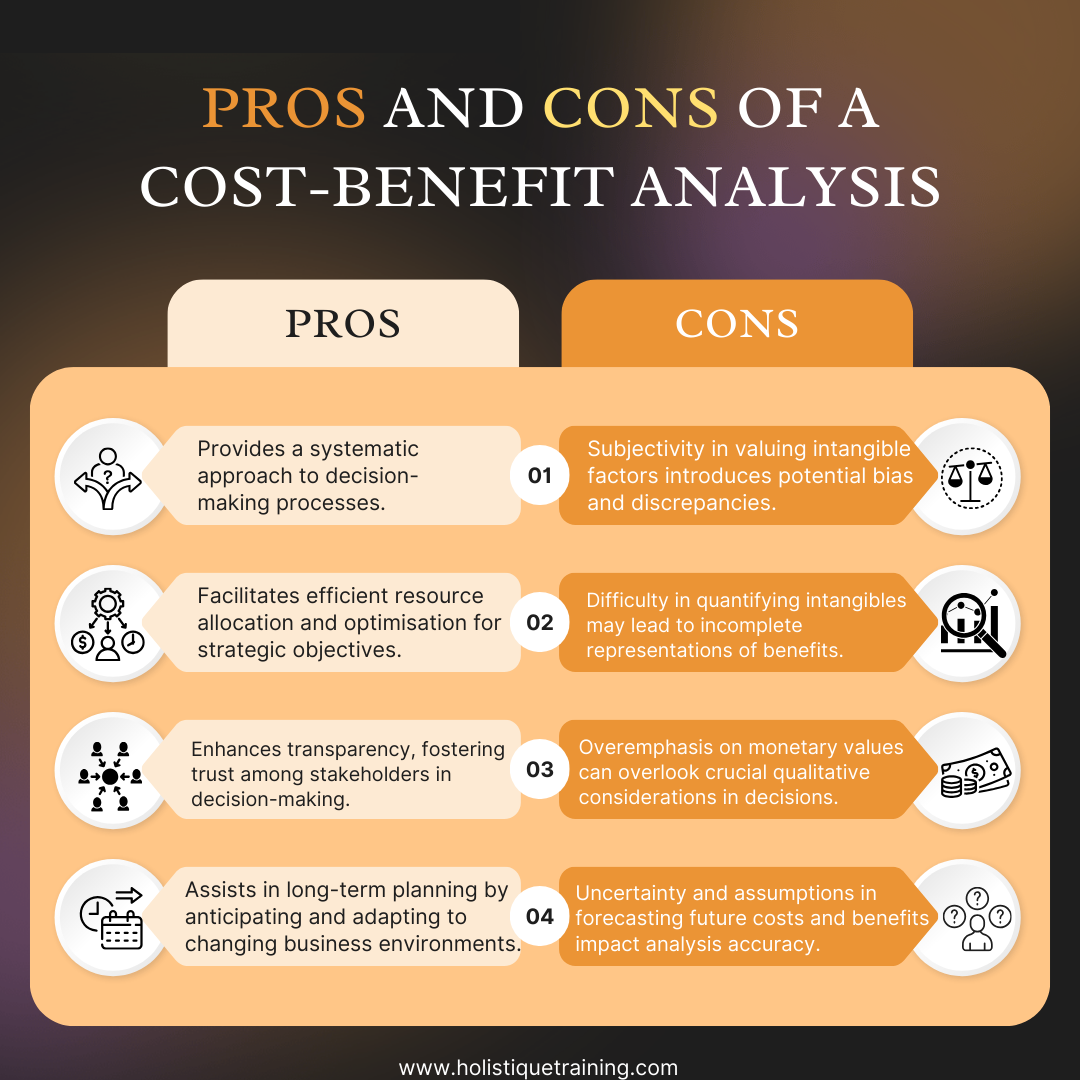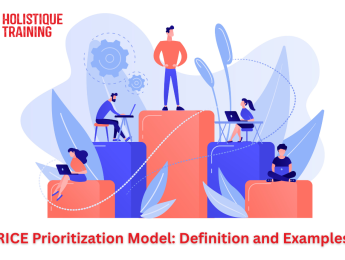Introduction
Decision-making lies at the heart of every business venture, and the choices we make can significantly impact the success or failure of an endeavour. One powerful tool that aids in this decision-making process is Cost-Benefit Analysis (CBA). In this comprehensive guide, we will explore the intricacies of CBA, its formula, the steps involved in creating one, the reasons companies turn to it, its advantages, limitations, and the tools or methods employed. Additionally, we'll delve into the impact of technology on this indispensable decision-making approach.
What Is Cost-Benefit Analysis?
Cost-Benefit Analysis, at its core, is a systematic approach to evaluating the potential benefits and costs associated with a particular project or decision. It provides a structured framework for decision-makers to assess whether the benefits derived from a decision outweigh the associated costs. By quantifying both tangible and intangible factors, CBA serves as a compass, guiding organisations towards informed choices that align with their overarching goals.
What Is the Formula for CBA?
At the heart of CBA lies a simple yet powerful formula:
Total Benefits/Total Costs
This ratio serves as a key metric in determining the feasibility and desirability of a given decision or project. A CBA with a ratio greater than 1 suggests that the benefits outweigh the costs, indicating a potentially sound investment.
Main Reasons a Company Might Use a Cost-Benefit Analysis
Strategic Decision-Making
In the dynamic and ever-changing landscape of business, strategic decision-making is paramount. Companies engage in Cost-Benefit Analysis (CBA) to chart a course that aligns with their overarching objectives and ensures sustainable growth. By systematically weighing the potential benefits against the associated costs, organisations gain a comprehensive understanding of the implications of their choices.
Strategic decisions can encompass a myriad of scenarios, from entering new markets to adopting cutting-edge technologies. Through CBA, companies can evaluate the long-term impact of these decisions, considering factors such as market trends, competitive forces, and the evolving needs of their customer base. This analytical approach empowers decision-makers to make choices that not only meet immediate needs but also position the company strategically for the future.
Resource Allocation
Resource allocation is a perpetual challenge for companies operating in a world of finite resources. CBA serves as a guiding light in this endeavour, offering a structured framework to optimise the use of resources, be it financial capital, manpower, or time.
In scenarios where budgets are tight, and choices must be made, CBA allows decision-makers to identify projects or initiatives that promise the highest returns on investment. This meticulous evaluation ensures that limited resources are directed towards endeavours that align with the company's goals, fostering efficiency and minimising the risk of resource misallocation.
Project Evaluation
Before embarking on a new project, businesses turn to CBA as a compass to navigate the complexities that lie ahead. Project evaluation through CBA involves a meticulous examination of the potential benefits and costs associated with the initiative. This not only aids in understanding the financial implications but also serves as a risk mitigation strategy.
By identifying potential pitfalls and opportunities early in the planning phase, organisations can make informed adjustments to project parameters. This proactive approach enhances the likelihood of successful project implementation, reducing the chances of unforeseen challenges derailing the initiative.
Policy Assessment
Governments and regulatory bodies also leverage CBA to assess the potential impact of proposed policies. In the realm of public administration, decisions often carry far-reaching consequences for society at large. CBA provides a systematic and objective method for evaluating the costs and benefits of policy choices, ensuring that decisions are made with a comprehensive understanding of their implications.
Whether it's a new environmental regulation, tax policy, or public infrastructure project, CBA aids policymakers in assessing the potential economic, social, and environmental consequences. This approach contributes to the development of policies that strike a balance between the public good and the economic well-being of businesses.
In essence, the main reasons companies turn to CBA revolve around the pursuit of informed decision-making, efficient resource allocation, successful project implementation, and navigating the intricate landscape of regulatory policies. CBA is not merely a tool; it is a strategic ally that empowers organisations to navigate the complexities of the business world with foresight and precision.
What Are the 5 Steps of Creating a CBA?
1. Define the Scope and Objectives
The first crucial step in creating a Cost-Benefit Analysis (CBA) is defining the scope and objectives of the analysis. This involves clearly articulating the boundaries of the decision or project under consideration and establishing the goals that the analysis seeks to achieve.
Defining the scope ensures that the subsequent analysis remains focused and relevant. It requires a comprehensive understanding of the decision's context, identifying key stakeholders, and clarifying the intended outcomes. By setting the foundation for analysis, organisations pave the way for a systematic and meaningful evaluation of costs and benefits.
2. Identify Costs and Benefits
Once the scope and objectives are established, the next step involves identifying and documenting all relevant costs and benefits associated with the decision or project. This is a meticulous process that requires a comprehensive examination of both direct and indirect factors.
Costs may include initial investments, operational expenses, and potential future expenditures. On the other hand, benefits encompass monetary gains, improvements in efficiency, and any positive impact on the organisation's strategic goals. Identifying these elements is crucial for creating a comprehensive picture of the potential outcomes of the decision.
3. Assign Monetary Value
Assigning monetary values to costs and benefits is a critical step that bridges the gap between quantitative and qualitative factors. While some elements have straightforward financial values, such as direct expenses or revenue generation, others, like employee satisfaction or brand reputation, require a more nuanced approach.
In this step, decision-makers must leverage various valuation techniques, including market prices, expert opinions, or surveys, to attach monetary values to intangible factors. The goal is to ensure that all aspects of the decision, tangible and intangible, are considered in a unified monetary framework.
4. Calculate Net Present Value (NPV)
The concept of the time value of money recognises that a dollar today is worth more than a dollar in the future due to factors such as inflation and the opportunity cost of capital. To address this, the Net Present Value (NPV) is calculated by discounting future costs and benefits to their present value.
NPV is a pivotal metric in CBA, providing decision-makers with insights into the financial viability of a project over its lifespan. A positive NPV indicates that the benefits outweigh the costs, suggesting that the investment is potentially worthwhile.
5. Conduct Sensitivity Analysis
Recognising the inherent uncertainties in any decision or project, the final step involves conducting a sensitivity analysis. This involves exploring how variations in key variables may impact the overall cost-benefit ratio.
By testing the robustness of the analysis against different scenarios, decision-makers can identify potential risks and uncertainties. This information is invaluable for developing contingency plans and understanding the range of potential outcomes, contributing to more robust and resilient decision-making.
In essence, the five steps of creating a CBA form a comprehensive and iterative process. They guide decision-makers from defining the scope and objectives to conducting a nuanced analysis that accounts for the time value of money and uncertainties. This systematic approach ensures that decisions are not only well-informed but also adaptable to the complexities of the business environment.
Advantages of Cost-Benefit Analysis
Informed Decision-Making
One of the primary advantages of Cost-Benefit Analysis (CBA) is its ability to provide decision-makers with a comprehensive understanding of the potential consequences of a choice. In the intricate web of business decisions, where outcomes are often multifaceted, CBA serves as a beacon, illuminating the path forward.
By systematically evaluating the benefits and costs associated with a decision, organisations gain insights into the overall impact on their objectives. This informed decision-making approach is especially crucial in situations where choices carry significant implications for the future. Whether it's entering a new market, adopting a new technology, or launching a new product, CBA ensures that decision-makers have a clear understanding of the potential outcomes.
Resource Optimisation
Efficient resource allocation is a perpetual challenge for organisations operating in resource-constrained environments. CBA acts as a strategic tool for optimising resource deployment, ensuring that limited resources are directed towards initiatives with the highest potential for positive outcomes.
Through a systematic assessment of costs and benefits, decision-makers can identify projects or activities that promise the most significant return on investment. This not only enhances the organisation's efficiency but also minimises the risk of misallocating resources. In essence, CBA empowers organisations to do more with less, fostering a culture of resource optimisation.
Transparency and Accountability
Transparency is the cornerstone of effective leadership, and CBA contributes to the openness and accountability of decision-making processes. By quantifying the rationale behind a decision through a structured analysis, organisations foster trust among stakeholders.
Stakeholders, whether internal or external, can comprehend the logic and reasoning that led to a specific decision. This transparency enhances the credibility of the decision-making process and ensures that decisions are not arbitrary but grounded in a systematic evaluation of costs and benefits. This transparency, coupled with accountability, strengthens the organisational fabric and promotes a culture of responsible decision-making.
Long-Term Planning
Businesses do not operate in isolation; they are part of a dynamic ecosystem influenced by evolving market trends, technological advancements, and changing consumer behaviours. CBA's forward-looking nature equips organisations with the ability to plan for the long term.
By considering the future value of investments and projects, decision-makers can anticipate and adapt to changes in the business environment. This proactive approach to long-term planning is invaluable in an era where agility and adaptability are essential for sustained success.
Comparative Analysis
In situations where multiple options are on the table, CBA facilitates a comparative analysis that aids decision-makers in prioritising initiatives based on their potential returns. This is particularly relevant in resource-allocation decisions, where competing projects vie for attention and investment.
The ability to objectively compare and contrast different options ensures that resources are directed towards initiatives that align most closely with organisational priorities. This not only enhances the effectiveness of decision-making but also contributes to the overall strategic alignment of the organisation.
In short, the advantages of Cost-Benefit Analysis extend beyond mere financial metrics. CBA empowers organisations to make informed decisions, optimise resource allocation, foster transparency and accountability, engage in long-term planning, and conduct effective comparative analyses. As a result, organisations that embrace CBA position themselves for strategic success in an ever-evolving business landscape.
Limitations of Cost-Benefit Analysis
Subjectivity in Valuation
One of the inherent challenges of Cost-Benefit Analysis (CBA) lies in the subjective nature of valuing certain factors, particularly intangibles. While monetary values can be easily assigned to tangible costs and benefits, aspects like employee satisfaction, brand reputation, or environmental impact often resist precise quantification.
Different stakeholders may assign different values to these intangible factors based on their perspectives, leading to a degree of subjectivity in the analysis. This subjectivity can introduce variability into the final assessment and potentially skew decision outcomes.
Difficulty in Quantifying Intangibles
Certain benefits, such as increased brand loyalty or enhanced public goodwill, are challenging to quantify accurately. These intangible factors, though influential, often lack concrete metrics for measurement. As a result, CBA may not fully capture the complete spectrum of benefits associated with a decision.
This limitation can lead to an incomplete representation of the potential positive outcomes, potentially undervaluing the overall benefits of a project or decision. Decision-makers must be cognizant of this challenge and seek alternative methods to qualitatively assess these unmeasurable aspects.

Overemphasis on Monetary Values
CBA predominantly relies on monetary values, potentially overlooking qualitative factors that may be crucial for the success of a project. Factors such as employee morale, corporate culture, or social responsibility may not be fully captured within the confines of monetary metrics.
Overemphasising monetary values can result in decisions that prioritise short-term financial gains at the expense of long-term sustainability or brand reputation. Organisations need to strike a balance between quantitative and qualitative considerations to ensure a holistic evaluation.
Uncertainty and Assumptions
The future is inherently uncertain, and CBA requires making assumptions about future costs and benefits. Changes in economic conditions, market dynamics, or technological advancements may deviate from these assumptions, impacting the accuracy of the analysis.
This limitation underscores the importance of regularly revisiting and updating CBA models as circumstances evolve. Decision-makers should be mindful of the dynamic nature of the business environment and the potential for unforeseen changes that could influence the validity of their initial assumptions.
Ignores Distributional Impacts
CBA may not adequately account for the distributional impacts of a decision, especially when costs and benefits affect different stakeholders disparately. While the overall cost-benefit ratio may appear favourable, certain groups or individuals may bear a disproportionate share of the costs or enjoy a disproportionate share of the benefits.
This oversight raises ethical and social equity concerns, as decisions that disproportionately impact vulnerable populations or certain demographics may not align with broader societal values. A more nuanced approach, such as incorporating equity considerations into the analysis, is necessary to address this limitation.
In summary, while Cost-Benefit Analysis is a valuable decision-making tool, it is not without its limitations. Subjectivity in valuation, the difficulty in quantifying intangibles, an overemphasis on monetary values, uncertainty and assumptions, and the oversight of distributional impacts all pose challenges to the comprehensive assessment of decisions. Acknowledging these limitations is crucial for decision-makers to use CBA judiciously and supplement it with qualitative insights when necessary.
Tools or Methods Used in a CBA
1. Cost-Effectiveness Analysis (CEA)
Cost-Effectiveness Analysis (CEA) is a method closely related to CBA but with a specific focus on comparing the relative costs and outcomes of different courses of action. Particularly useful when the primary goal is to achieve a specific outcome with the least cost, CEA enables decision-makers to optimise resource use and achieve efficiency in their choices.
2. Risk Analysis
Incorporating risk analysis tools is essential for a comprehensive CBA. Techniques such asMonte Carlo simulations allow decision-makers to explore potential uncertainties and their impact on the overall analysis. By quantifying risks and assessing their probability, organisations can make more informed decisions and develop strategies to navigate uncertainties effectively.
Table 1: Different risk types in CBA
Risk Type | Description | Mitigation Strategy |
Financial Risks | Monetary uncertainties impacting the project. | Diversification of investments |
Market Risks | External factors affecting market conditions. | Scenario planning |
Operational Risks | Internal challenges hindering project execution. | Robust project management |
Regulatory Risks | Changes in regulations impacting the decision. | Regular compliance checks |
Reputational Risks | Negative impact on the organisation's image. | Communication strategy |
3. Decision Trees
Decision trees serve as visual representations that help map out various decision paths and their associated probabilities. This method aids in evaluating complex decision scenarios by providing a clear and structured visualisation of the potential outcomes. Decision trees are particularly useful in situations where choices lead to a series of interconnected decisions, helping decision-makers make informed choices.
4. Break-Even Analysis
Break-Even Analysis is a method that determines the point at which the benefits and costs of a decision or project are equal. This analysis is crucial in identifying the threshold at which an initiative becomes financially viable. By pinpointing the break-even point, decision-makers can understand the minimum level of performance required for a project to be considered economically sound.
5. Contingent Valuation
When valuing intangible factors proves challenging, contingent valuation methods come into play. This approach involves directly asking individuals or stakeholders to express their willingness to pay for a particular benefit. By engaging with stakeholders and quantifying their preferences, organisations can assign values to intangible factors, contributing to a more comprehensive CBA.
In summary, the tools and methods used in a Cost-Benefit Analysis are diverse and cater to the multifaceted nature of decision-making. From optimising efficiency with Cost-Effectiveness Analysis to visualising decision paths using Decision Trees, these tools enrich the CBA process, enabling organisations to make more informed and strategic choices.
How Does Technology Affect a CBA?
The advent of technology has transformed the landscape of decision-making, and CBA is no exception. Technological advancements have introduced efficiency, precision, and accessibility to the CBA process.
1. Data Analytics
The advent of technology has ushered in an era where data is abundant and accessible.Data analytics tools play a pivotal role in enhancing the robustness of Cost-Benefit Analysis (CBA). These tools can process vast amounts of data, providing decision-makers with deeper insights into costs, benefits, and potential risks associated with a decision.
Advanced analytics not only streamline the data collection process but also enable more sophisticated modelling and scenario analysis. By leveraging data analytics, organisations can enhance the accuracy of their CBA, making it a more reliable guide for decision-making in complex and dynamic business environments.
2. Simulation Software
Sophisticated simulation software has become an indispensable asset in the realm of CBA. Decision-makers can use these tools to model various scenarios and assess their impact on the overall cost-benefit ratio. Simulations provide a dynamic view of how different variables interact and influence the outcomes of a decision.
By incorporating simulation software into the CBA process, organisations can better understand the potential risks and uncertainties associated with a decision. This proactive approach aids in developing contingency plans and mitigating potential challenges before they manifest in the real world.
3. Collaboration Platforms
Cloud-based collaboration platforms have transformed the way teams work together, regardless of geographical locations. This technological advancement is particularly beneficial in the context of CBA, where input from various experts in finance, marketing, operations, and other domains is crucial.
Collaboration platforms facilitate real-time sharing of data, insights, and updates, allowing diverse teams to contribute to the CBA process seamlessly. This collaborative approach ensures that decision-makers have access to the most up-to-date information and insights from all relevant stakeholders.
4. Artificial Intelligence (AI)
The integration of Artificial Intelligence (AI) into the CBA process has profound implications for decision-making. AI and machine learning algorithms can analyse complex data sets, identify patterns, and make predictions. In the context of CBA, AI enhances the accuracy of forecasting and provides more nuanced insights into potential outcomes.
AI can contribute to predictive modelling, helping decision-makers anticipate future trends and factors that may impact costs and benefits. This foresight enables organisations to make more proactive and strategic decisions, leveraging the power of technology to stay ahead in a rapidly evolving business landscape.
5. Blockchain for Transparency
Blockchain technology, known for its decentralised and transparent ledger system, can be employed to enhance the transparency and accountability of CBA. As data integrity is paramount in decision-making, blockchain ensures that the information used in the analysis remains tamper-proof and verifiable.
By incorporating blockchain into the CBA process, organisations can address concerns related to data manipulation and integrity. This technology adds an additional layer of security, fostering trust in the accuracy of the data and the reliability of the CBA outcomes.
In summary, technology has become an integral enabler in the realm of Cost-Benefit Analysis. From advanced data analytics and simulation software to collaboration platforms, AI, and blockchain, technology empowers organisations to conduct more sophisticated, accurate, and transparent CBAs. As businesses continue to embrace technological advancements, the synergy between technology and CBA will likely play a pivotal role in shaping the future of decision-making processes.
In Conclusion
Cost-Benefit Analysis stands as a powerful compass in the sea of decision-making, guiding organisations towards choices that align with their strategic objectives. By understanding the formula, steps, reasons, advantages, limitations, and tools involved in CBA, decision-makers can navigate complex scenarios with clarity and precision. Embracing the transformative effects of technology further amplifies the efficacy of CBA, ushering in a new era of informed and data-driven decision-making. As businesses continue to evolve, the role of CBA remains pivotal, ensuring that each choice contributes to the sustainable growth and success of the organisation.
In your journey to mastering the art of decision-making, consider enrolling in our exclusive course, ‘Advanced Budget Management and Cost Allocation.’ Equip yourself with advanced skills to elevate your CBA proficiency, ensuring your decisions not only align with strategic objectives but also pave the way for unparalleled success in a rapidly evolving business landscape. Enrol now and unlock the keys to strategic financial mastery!
























